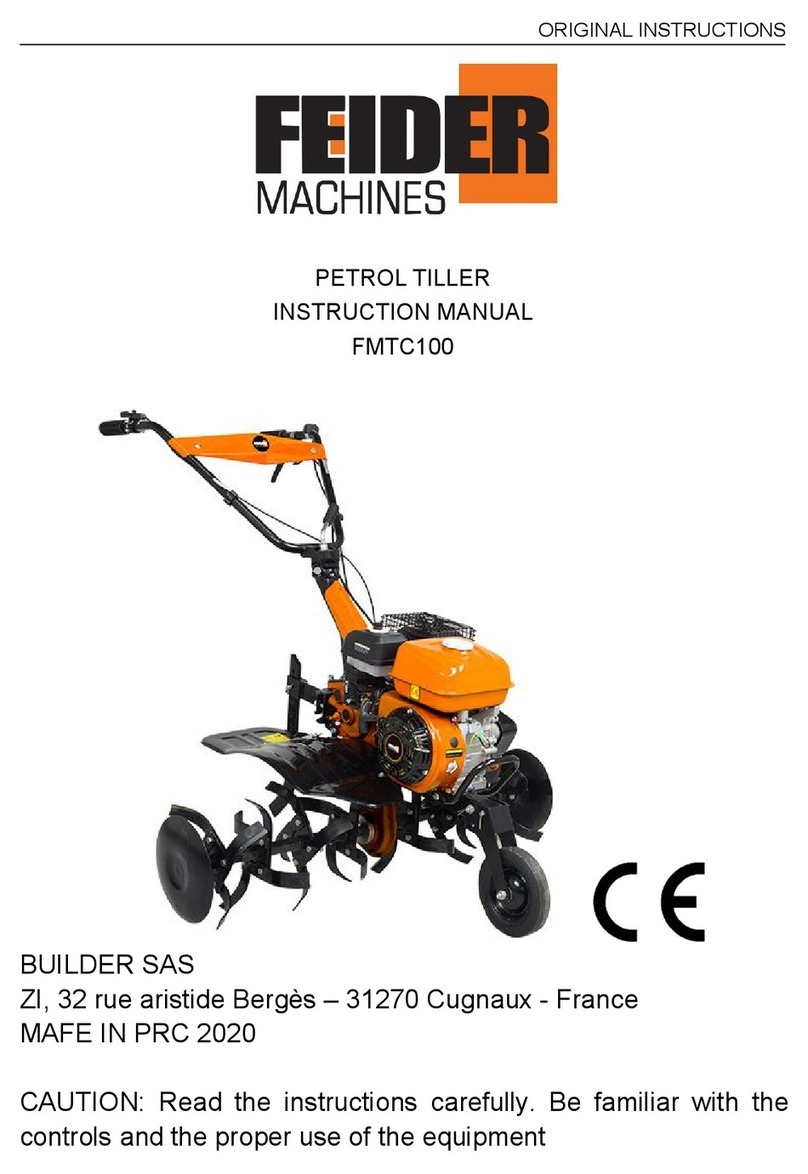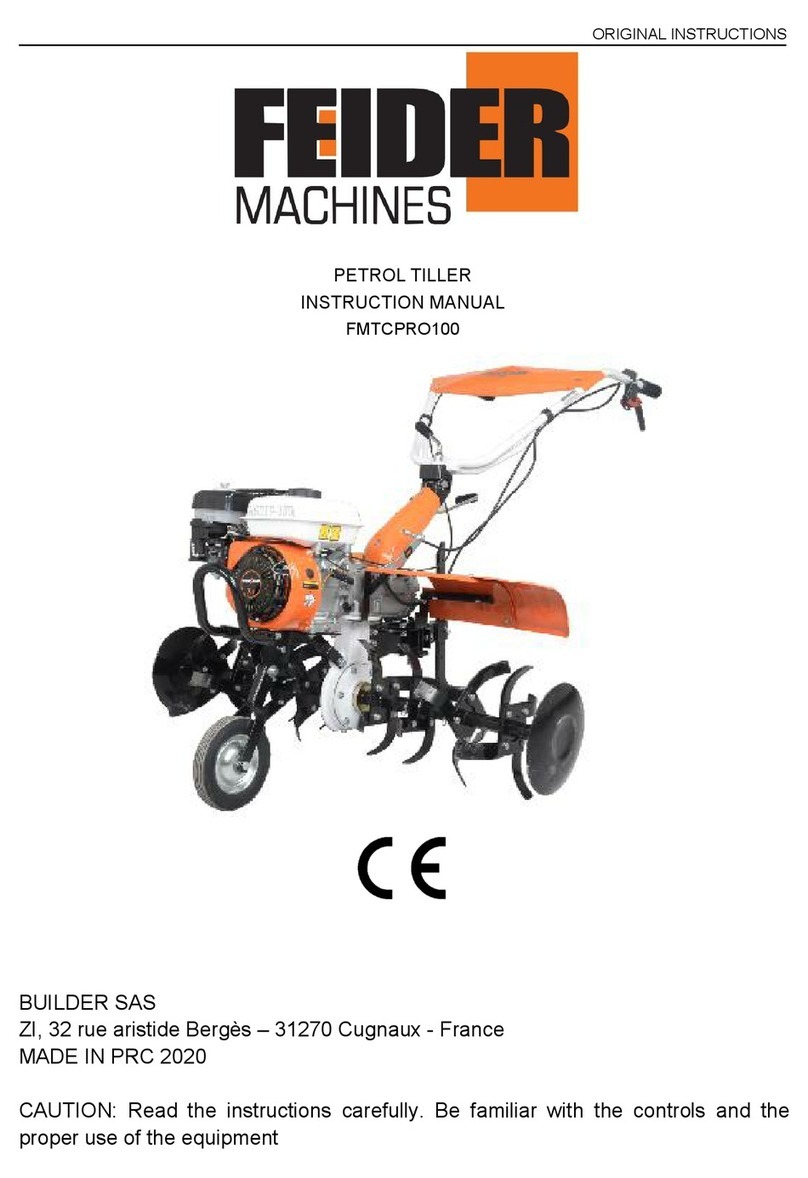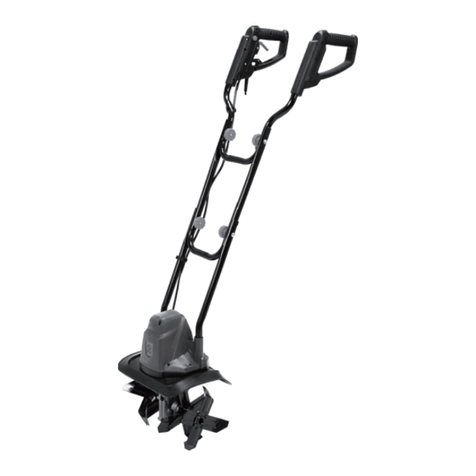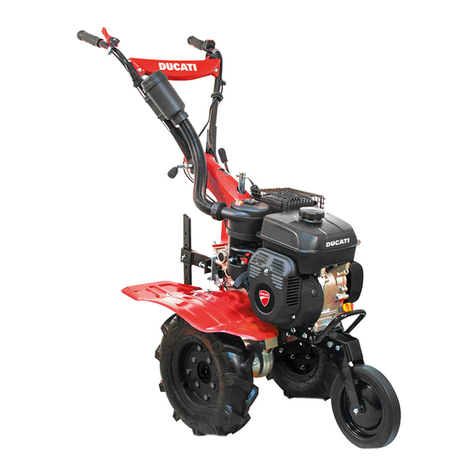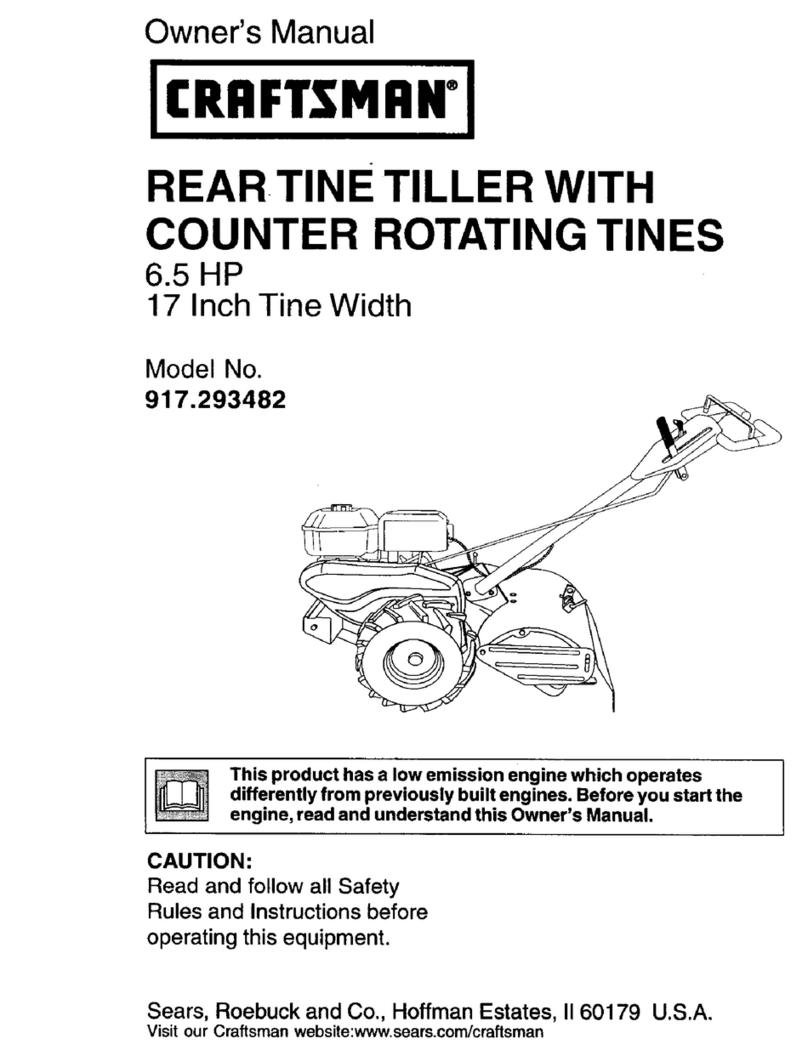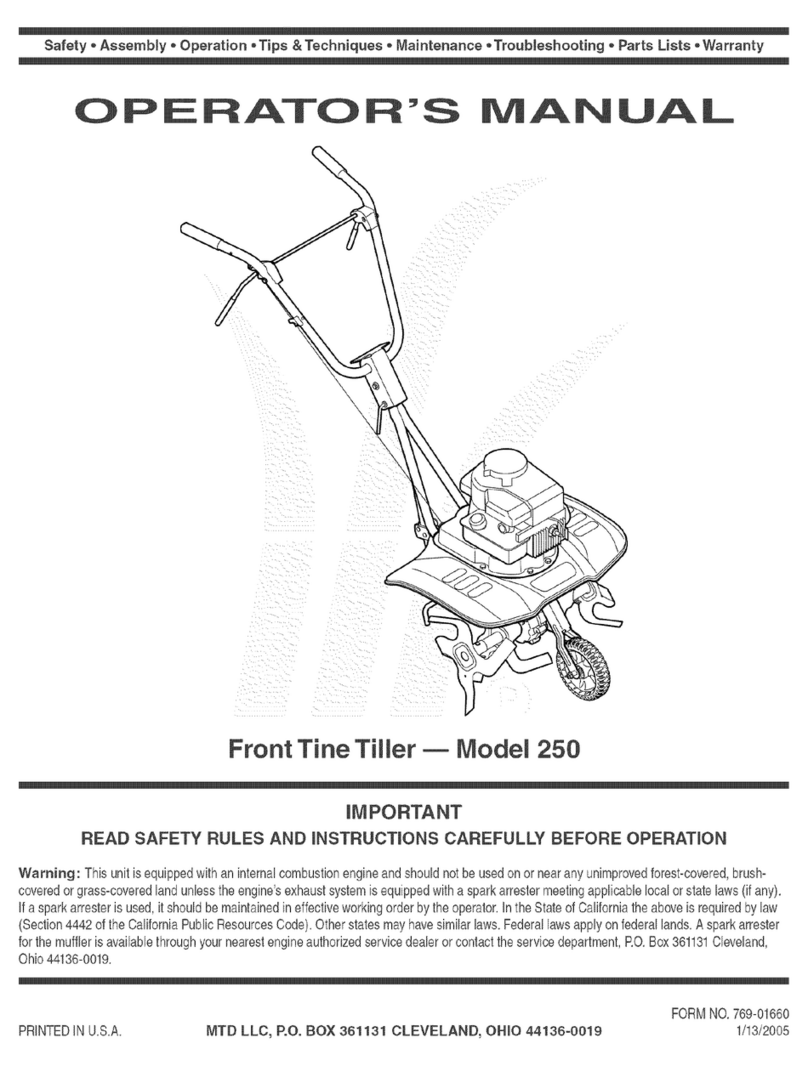Feider Machines FMTB50 User manual

ORIGINAL INSTRUCTIONS
PETROL TILLER
INSTRUCTION MANUAL
FMTB50/FMTB80
CAUTION: Read the instructions carefully. Be familiar with the
controls and the proper use of the equipment
BUILDER SAS
ZI, 32 rue aristide Bergès – 31270 Cugnaux - France
MAFE IN PRC 2021

1.
SAFETY WARNING:
For your safety and safety of others please pay special attention to these
precautions:
1)
Training
a)
Read the instructions carefully. Be familiar with the controls and the
proper use of the equipment;
b)
Never allow children or people unfamiliar with these instructions to use
the machine. Local regulations can restrict the age of the operator;
c)
Never work while people, especially children, or pets are nearby;
d)
Keep in mind that the operator or user is responsible for accidents or
hazards occurring to other people or their property.
2)
Preparation
a)
While working, always wear substantial footwear and long trousers. Do
not operate the equipment when barefoot or wearing open sandals;
b)
Thoroughly inspect the area where the equipment is to be used and
remove all objects which can be thrown up by the machine;
c)
WARNING – Petrol is highly flammable:
Store fuel in containers specifically designed for this purpose;
Refuel outdoors only and do not smoke while refuelling;
Add fuel before starting the engine. Never remove the cap of the
fuel tank or add petrol while the engine is running or when the
engine is hot;
If petrol is spilled, do not attempt to start the engine but move the
machine away from the area of spillage and avoid creating any
source of ignition until petrol vapours have dissipated;
Replace all fuel tank and container caps securely;
d)
Replace faulty silencers;
e)
Before using, always visually inspect to see that the tools are not worn
out or damaged. Replace worn out or damaged elements and bolts in sets
to preserve balance.
3)
Operation
a)
Do not operate the engine in a confined space where dangerous carbon
monoxide fumes can collect;

b)
Work only in daylight or in good artificial light;
c)
Always be sure of your footing on slopes;
d)
Walk, never run with the machine;
e)
For wheeled rotary machines, work across the slopes, never up and
down;
f)
Exercise extreme caution when changing direction on slopes;
g)
Do not work on excessively steep slopes;
h)
Use extreme caution when reversing or pulling the machine towards you;
i)
Do not change the engine governor settings or overspeed the engine;
j)
Start the engine carefully according to manufacturer instructions and with
feet well away from the tool(s);
k)
Do not put your hands or feet near or under rotating parts;
l)
Never pick up or carry a machine while the engine is running;
m)
Stop the engine:
Whenever you leave the machine;
Before refuelling;
n)
Reduce the throttle setting during engine shut down and, if the engine is
provided with a shut-off valve, turn the fuel off at the conclusion of working;
4)
Maintenance and storage
a)
Keep all nuts, bolts and screws tight to ensure the equipment is in safe
working condition;
b)
Never store the equipment with petrol in the tank inside a building where
fumes can reach an open flame or spark;
c)
Allow the engine to cool before storing in any enclosure;
d)
To reduce the fire hazard, keep the engine, silencer, battery
compartment and petrol storage area free of vegetative material and
excessive grease;
e)
Replace worn or damaged parts for safety;
f)
If the fuel tank has to be drained, this shall be done outdoors.
Thrown Object Hazard
Objects hit by the rotating tines can be thrown from the tiller with great force
and may cause severe injury.
1)
Before tilling, clear the tilling area of sticks, large stones, wire, glass

etc.
2)
Pieces thrown from worn or damaged-tines can cause serious injury.
Always inspect the tines before using the tiller.
Fire and Burn Hazard
Gasoline is extremely flammable and gasoline vapor can explode.
Use extreme care when handing gasoline. Keep gasoline out of reach of
children.
1)
Refuel in a well-ventilated area with the engine stopped.
2)
Allow the engine to cool before refueling. Fuel vapor or spilled fuel
may be ignited.
3)
The engine and exhaust system becomes very hot during
operation and remains hot after stopping. Touching them can cause burn
injuries or some materials burn.
4)
Avoid touching a hot engine or exhaust system.
5)
Allow the engine to cool before performing maintenance or storing
the tiller indoors.
Carbon Monoxide Poisoning Hazard
Exhaust contains poisonous carbon monoxide a colorless and odorless gas.
Breathing exhaust can cause loss of consciousness and may lead to death.
Operation on Slope
1)
When tilling on slopes, keep the fuel tank with less than half oil to
minimize fuel spillage.
2)
When the tiller walks across the slope, put your effort evenly while
walking up and down the slope.
3)
Be very careful when changing the direction of the tiller on a slope.
4)
Do not use the tiller on a slope of more than 10°.
5)
The maximum safe grade angle shown is for reference only and
the details should depend on the type of the tool. Before starting the engine,
check that the tiller is not damaged and in good condition. For your safety
or safety of others, pay special attention when using the tiller up or down hill.

2.
WARNING SYMBOL
Attention!
Caution: fire risk!
The part is extremely hot! Do not touch!
Read the instruction manual before use
Caution: Do not put your hands in belt when it
running.
Caution: rotating working tool!
Keep away from the machine.
Warning: Exhaust emissions are harmful to
health of body.
Add engine oil.

That the machine shall always be used in accordance with these
manufacturer's instructions the instruction handbook
The engine shall be stopped when carrying out maintenance and
cleaning operations, when changing tools and when being transported
by means other than under its own power;
Some hazards can be met when working on slopes; work slowly by
holding firmly the tool. Do not transport the tool on slopes. The hazards
can rise when working on difficult soil (stony, hard, etc.). there is a risk
to hit some objects, sliding, lose control for the machine which will gives
damages. Always inspect the working area before working, and always
watch what you are doing.
The adjustable part of the protective device shall be adjusted to the
working depth of the tool so that only that part of the working tool that
cuts into the soil remains uncovered. This does not apply to motor hoes.
The machine should only be operated by suitably trained persons.
During the operation of the machine safety shoes should be worn.
Always start up the machine under normal conditions.
Intended use
This device is to be used only as an electric hoe for aerating lawns and
grassy areas in private home gardens and pleasure gardens. It is not
intended for use in public spaces, parks, sports fields, agriculture or forestry.
Use of this device for any other purpose is considered incorrect and
unapproved. The manufacturer will not be responsible for any damage or
injury resulting from such use. The user is fully responsible for all related
risks.

3. STRUCTURAL
REPRESENTATION
ORIGINAL INSTRUCTIONS
1.
Engine Switch
2.
Clutch Handle
3.
Handle Bar
4.
Reverse handle
5.
Throttle lever
6.
Belt Cove
7.
Walking Wheel
8.
Blade
9.
Gearbox Assy
10.
Fender
11.
Engine
12.
Silencer
13.
Air filter
14.
Recoil start

ORIGINAL INSTRUCTIONS
4.
ASSEMBLY
The machine is packed in a box of the following dimensions :
LENGTH: 69CM
WIDTH: 38CM
HEIGHT: 77CM
The engine fitted on this cultivator have following features:
Exhaust guard
Recoil starter
Dry air filter
ENGINE LUBRICATION WITH: see instruction manual of the engine.
Quantity of engine oil: see instruction manual of the engine.
Fuel: unleaded petrol
Safety device for forward gear stopping the tiller.
The model FMTB50/FMTB80 has a front belt transmission for the
engine and a greased chain for the tiller.
The handlebar can be:
1.
adjustable in 1 vertical positions
2.
adjustable in different positions (height and side)
The gear-box is screwed(Pitc.1).
(Pitc.1)
The Resistance plough can be adjustable (Pitc.2).

(Pitc.2)
All the identification references (code number, engine, weight, power)
are printed on the number plate on the machine (Pitc.3).
(Pitc.3)
1)
Take the machine out of the carton box.
2)
Fit the two tillers to the main shaft using the delivered screws and nuts.
3)
Fit the rear spur in its place using the delivered bolt and both pins
which are on the spur holder.
4)
Fit the handlebar on the support:
a.
The model with the vertical adjustment is fitted with two screws
and nuts already fitted on the handlebar.
b.
The model with the full-side adjustment (rack, wheel system) is
fitted with the parts already mounted on the handlebar holder.
5)
The front wheel fixed by bolt(M12*80),Nut M12. And pull front wheel
till B type axis pin fixed when you do not use front wheelThe wheels
can be adjusted up and

down(see Pitc.4).
(Pitc.4)
6)
Fit the two guard-extensions to the main tiller protections fitted on the
body of the machine using the proper screws and nuts. The fender
should reach a width of 60 cm according to CE norms.
7)
To make the transport easier it is possible to keep the handlebar
disassembled, by means of the two screws in one version or by means
of the thread bushing in the other one, that fix it to the handlebar holder.
5. STARTING AND STOPPING
Starting the engine of the machine always follow these instructions very
carefully:
Check the oil in the engine:
THE BRAND NEW MACHINE IS DELIVERED WITHOUT OIL IN THE
ENGINE, THEREFORE YOU SHOULD FILL IT UP TO THE LEVEL ON THE
DIP STICK OF THE OIL CUP.
Please check the engine USE AND MAINTENANCE concerning the
“operations before staring”.
Start the engine only in open spaces.
1.Pull the choke lever on the engine(where present is).
2.Turn the accelerator lever to the “FAST” position (Pict.6).
Turn the
engine switch to the ON position
(Pict.5)
.
3.The clutch lever should be released (Pict.8 and Pict.9).
4.Pull the starting rope by the handle smoothly first than strongly: when you
feel some resistance don’t leave the handle but help the recoiling of the
rope with your hand (Pict.10).
5.When the engine runs move the choke lever to the initial position and the

accelerator lever in the mid-position.
6.For stopping the engine move the accelerator lever in “LOW” position
(Pict.5).
Turn the engine switch to OFF position
(Pict.7)
.
Pict.5 Pict.6
Pict.7 Pict.8
Pict.9 Pict.10

6.
USE AND ADJUSTMENT
6.1 Release clutch handle bar (pict8), Tiller stop.
6.2 When machine need reverse, Grasp reverse handle bar(pict9).
6.3 Model NO. FMTB50/FMTB80,Distance between belt is 52±5 mm.
Please note only take off screw from front supportor , and belt cover, then
you can check the belt distance,(see photo below).
if clutch is not working properly, The best way is adjust clutch cable nut to
proper position as photo below:
Grasp clutch handle bar, and loosen handle bar, the tension distance is
10mm, if you can not adjust distance to 10mm by nut, then please try
following method:
1,Take off bolt from engine supportor, and adjust position that you need.
Clutch
cable nut

The standard tiller is 55 cm wide(Pict.15), with two sets of knives on each side.
Adding other two sets of blades you can extend the tiller to 78 cm (Pict.15). The
blades of the tiller-knives should always be directed ahead, towards the front of
the machine
Pitc.15
7.
Technical Parameter
Model
FMTB50
FMTB80
Engine type
H170F
H170F
Rated engine
power
4.0kW
4.0kW
Engine rated
speed
3600/min
3600/min
Displacement
212cm3
212cm3
Tilling Width
550mm
800mm
Tilling Depth
≥100mm
≥100mm
Working speed
170/min
170min
800mm

-1, 0, +1
-1, 0, +1
(One forward gears,
(One forward gears,
Gear Shifts:
one neutral gear and
one neutral gear and
one reverse gear)
one reverse gear)
Blade Type
2-4 (4 sets 16Pcs)
3-4(6 sets 24Pcs)
Tyre Model
8×1.75
8×1.75
Carton
dimensions
580mm×400mm×74
0mm
580mm×400mm×
740mm
Net weight
54kg
57kg
Gross weight
56kg
59kg
Sound
pressur
e level measured
Left: 78,9 dB(A)
Right:80dB(A)
Sound
powe
r level measured
94,1 dB(A)
Guaranteed noise
level
98dB(A)
Vibration level
Left: 6,14m/s²
Right: 5,48 m/s²
K=1,5m/s²

8.
MAINTENANCE
Please note that maintenance operations are scheduled for normal
operating conditions. If the operation of tiller takes place under other
conditions, we recommend that you communicate with your dealer to
deal with the machine.
1.
Turn off the engine and disconnect the spark plug prior to
maintenance operations.
2.
Allow the engine and exhaust system to cool to avoid burns
from contacting with hot parts.
3.
It is important to keep safety gloves in the event that you need
to manipulate the blades.
4.
Wipe the dirt things on the machine.
5.
Remove the fuel from tiller if this is to be stored for longer than a month.
6.
It is appropriate to check that all bolts and nuts have not been loosened
after each session.
7.
The guard should be fixed after assembling and it should not be removed
or adjusted during use and maintenance
For the normal maintenance (oil, filter, spark plug) check the booklet for
the engine included.
The chain for the final transmission is lubricated with normal grease.
Every year you should introduce some grease through the hole “Q”
(Pict.14) in the main body.
Keep the machine and the tillers clean and check that all the screws
and nuts are well tied, especially the screws of the tiller (always wear
protection gloves working on the tiller).
In case of breaking or wearing you can replace the belt after taking off

the side protection cover fixed to the frame near the engine shaft by two
screws.
Remove the belt from the pulleys, install the new belt end adjust it
following the instructions mentioned in the chapter USE AND
ADJUSTMENT by checking the distance between both sides of the belt,
then replace the cover.
The pin fixing the big pulley has also a safety purpose: in case heavy
obstacle it will break avoiding damages to other parts of the machine.
The replacement of the pin is very easy: you have to insert the new pin
in the hole using a hammer.
For any technical repair especially during the guarantee period, it is
recommendable to apply to the specialized workshops of our dealers.
CAUTION:
It is advised not to keep the motor running when the machine is not being
used for its specific purpose.

9.
BREAKDOWN LIST
A.
Gasoline engine
(1)
Hard to start machine or fail to start
Breakdown
phenomenon
Cause
Solution
no
spark at
plug
spark plug
carbon deposition of
spark plug
clear away carbon
excessive or too
small clearance of
spark plug
adjust clearance to
0.7~0.8mm
Insulation damage of
spark plug
replace spark plug
Others
breakdown of ignitor
replace ignitor
weak magnetic force
of flywheel
replace flywheel
Sparkin
g at plug
good
compressi
on
suck excessive fuel
into cylinder
take off spark plug
and dry it and put it
on
poor quality of fuel
with water and dirt
replace fuel
Loosen oil
drain
screw at
the bottom
of
Carburetor
.No oil
shedding.
needle valve block
clean or replace
carburetor
normal oil
supply but
poor
compressi
on
piston ring abrasion,
loose spark plug
replace
Air leak of cylinder
head
screw tigh
wrong air valve
clearance or timing
clean, readjust and
reassemble
normal
ignition
and oil
supply
poor contact of high
voltage cable and
spark plug
replace and connect
Failure of stop
switch , short circuit
clean
breakdown of oil alert replace

(2)
Abnormal conditions in the movement
Breakdown
phenomenon
Cause
Solution
Insufficient power,
Low rotation
damper closed, poor
ventilation of muffler
open damper,
replace muffler
moving parts abrasion
check, replace
speed
adjustment
mechanism failed to
reach the best
equilibrium
adjust speed
adjustment
mechanism
low ignition power
replace ignitor or
flywheel
excessive clearance of
air valve
regulate to the
required scope
carbon deposition
Clear away carbon
excessive
fluctuation of speed
speed
adjustment
mechanism failed to
reach the most
optimized combination
adjust speed
adjustment
mechanism
wrong carburetor
replace carburetor
wrong space of spark
plug
adjust clearance
excessively high
speed of rotation
speed adjusting handle
failed to press adjust
cap tightly or Speed
adjust cap lost
Readjustor install
speed adjustment
cap
abnormal sound
wrong clearance of air
valve
adjust clearance of
air valve
cam gear injured
replace camshaft
oil leaking of
carburetor
needle valve and oil dirt
attached
lightly tap carburetor
or clean it.
O-ring deformation
replace

B.
Tiller
Abnormalities
Common Causes
Measures to be taken
Strange noises
Stuck blade
Turn off the tiller until
the engine is
completely stopped.
Leakage of lubricating
oil
Fix it in the repair
shop
Loose bolts, nuts and
other components
Tighten all the
components, if
strange noises
remain, please
contact repair shop
Strong vibration
Damage or wear of the
blade
Change blade or fix it
in repair shop
Excessive tillage depth
Adjust the tillage
depth
Poor tillage effect
Shallow tillage
Adjust the tillage
depth
Blunt or worn blade
Change blade o fix it
in repair shop

10.
CE Declaration of conformity
CE Declaration of conformity BUILDER
ZI, 32 rue aristide Bergès – 31270 Cugnaux - France
Declares that the machinery designated below:
PETROL TILLER
FMTB50/FMTB80
Serial number :
the national regulations transposing it;
Also complies with the following European directives:
Emission Directive (EU) 2016/1628 and 2018/989/EU
Directive EMC 2014/30 /EU
Also complies with European standards, national standards and technical
provisions following
EN 709:1997+A4; EN ISO 14982:2009
Philippe MARIE / PDG
Done at Cugnaux, le 01/02/2021
FMTB50: 20210453872-20210453941
FMTB80: 20210453942-20210454011
Complies with the provisions of the Directive "machinery" 2006/42 / EC and
This manual suits for next models
1
Table of contents
Other Feider Machines Tiller manuals
Popular Tiller manuals by other brands

Caravaggi
Caravaggi Ario 100 Series Use and maintenance instruction manual

Hyundai power products
Hyundai power products HMTB50 Original instructions
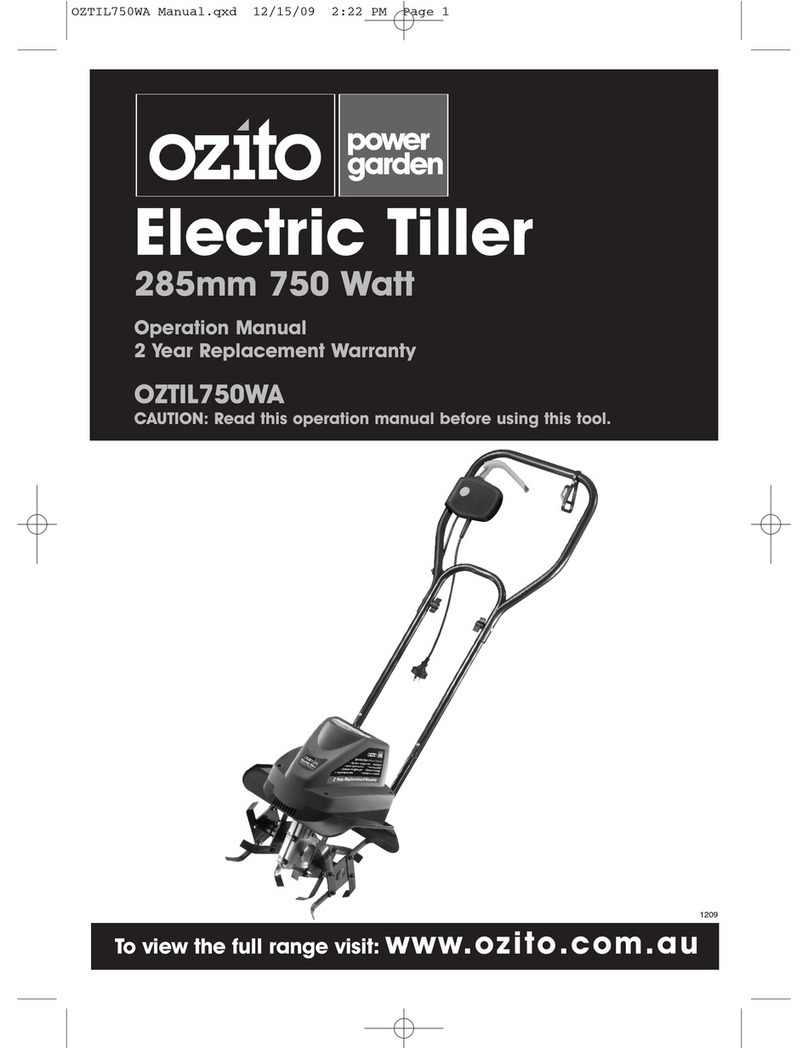
Ozito
Ozito OZTIL750WA Operation manual
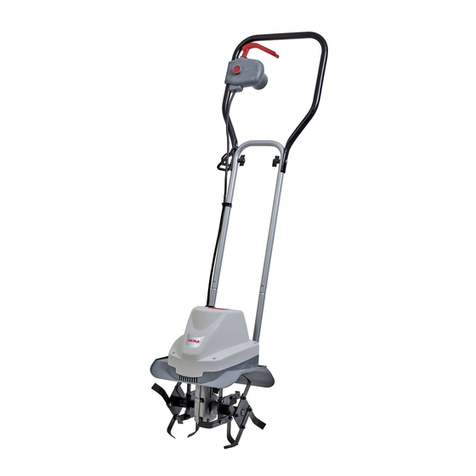
Ikra
Ikra IEM 750 operating instructions
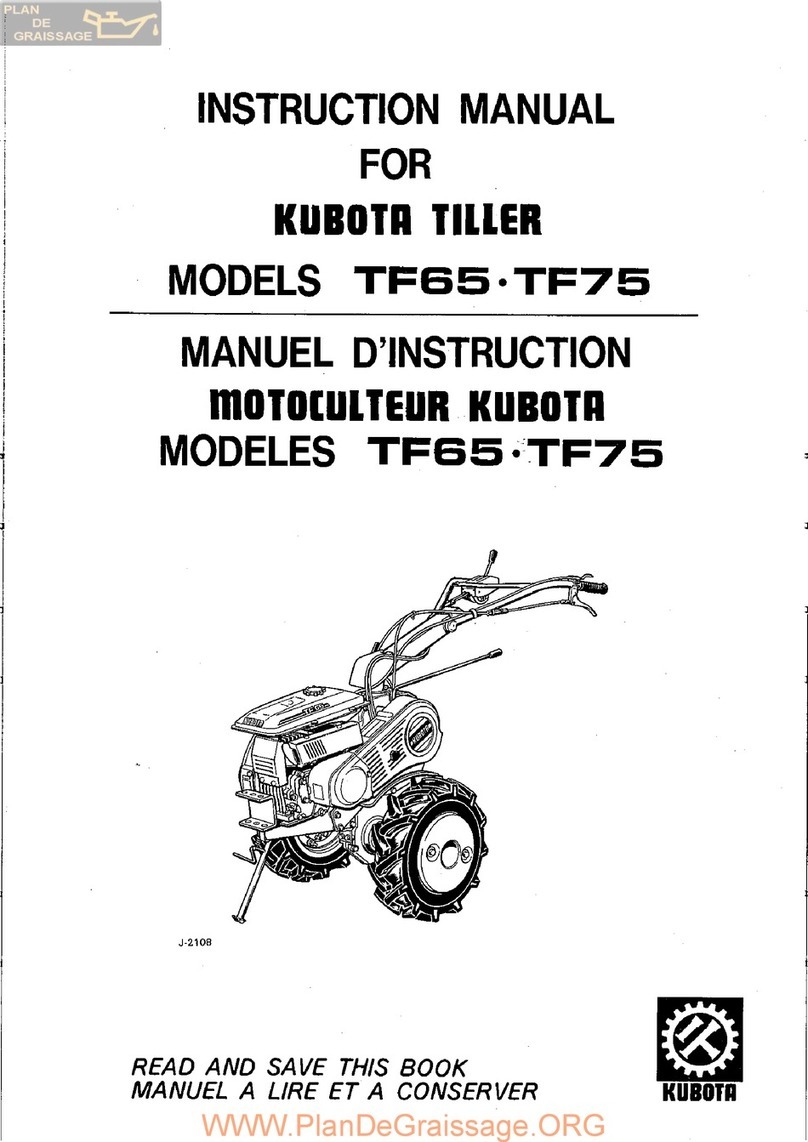
Kubota
Kubota TF65 instruction manual
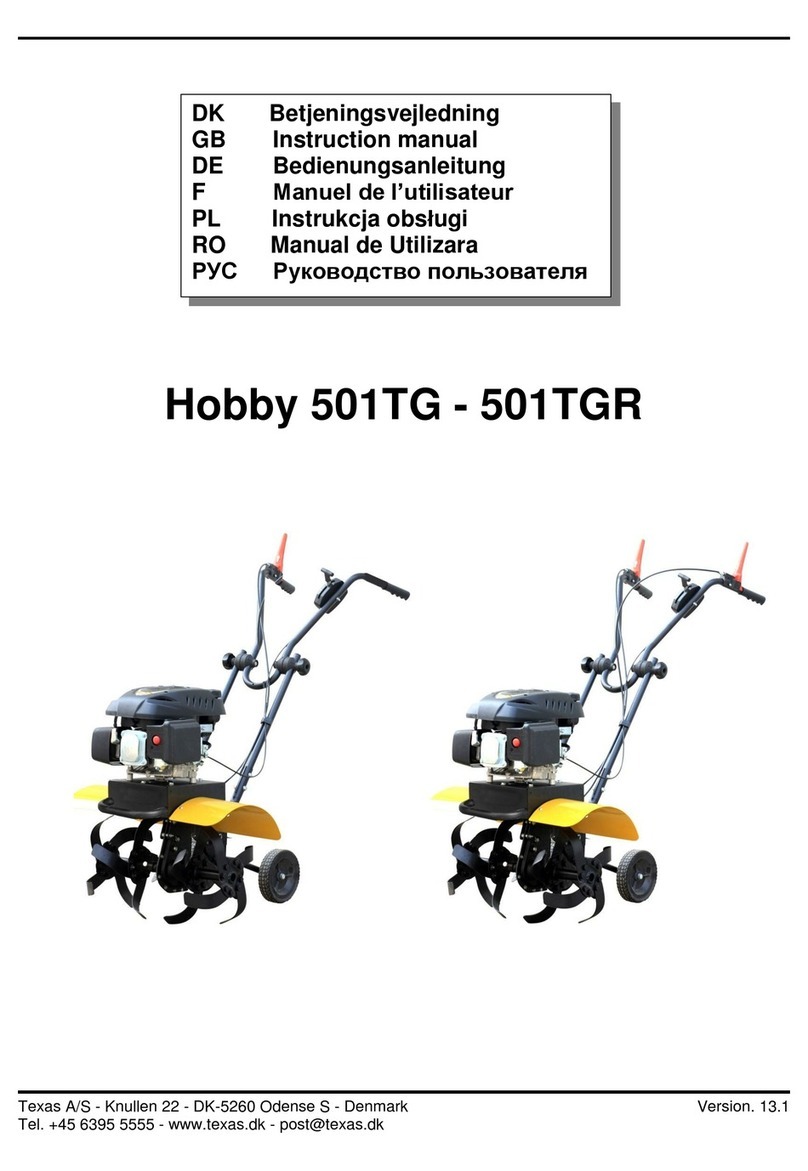
Texas
Texas Hobby 501TG instruction manual
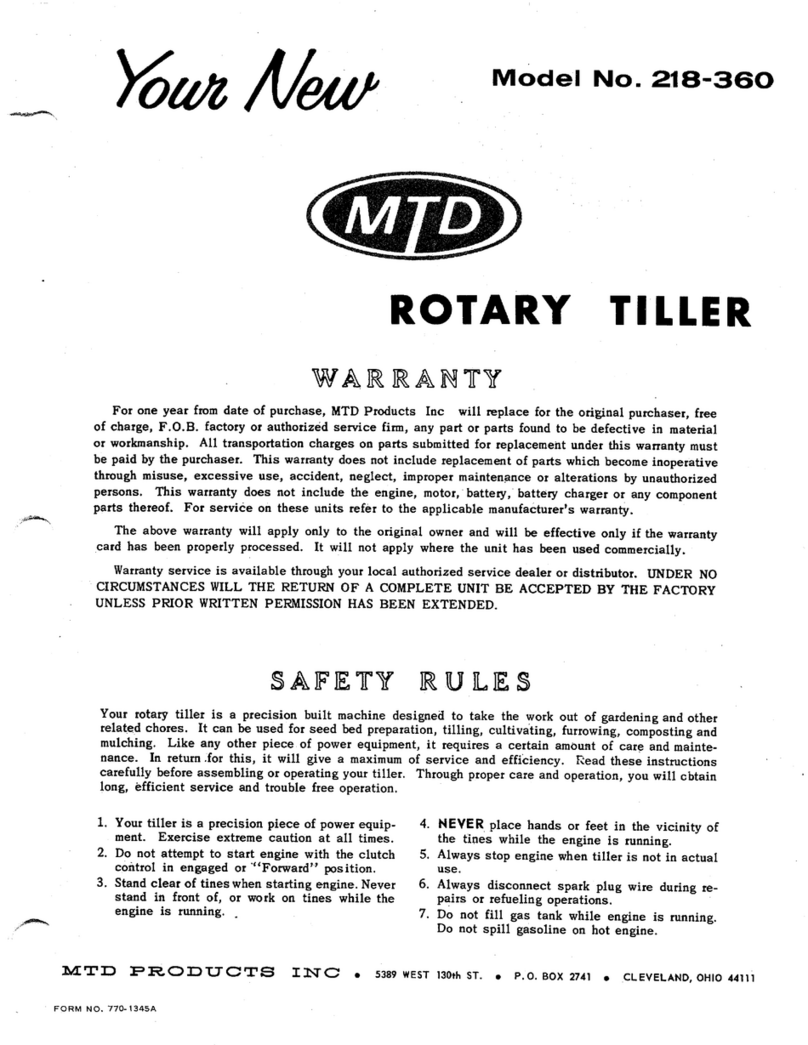
MTD
MTD 218-360 owner's manual

White Outdoor
White Outdoor ROTO BOSS 510 215-310-190 Parts list and instruction manual
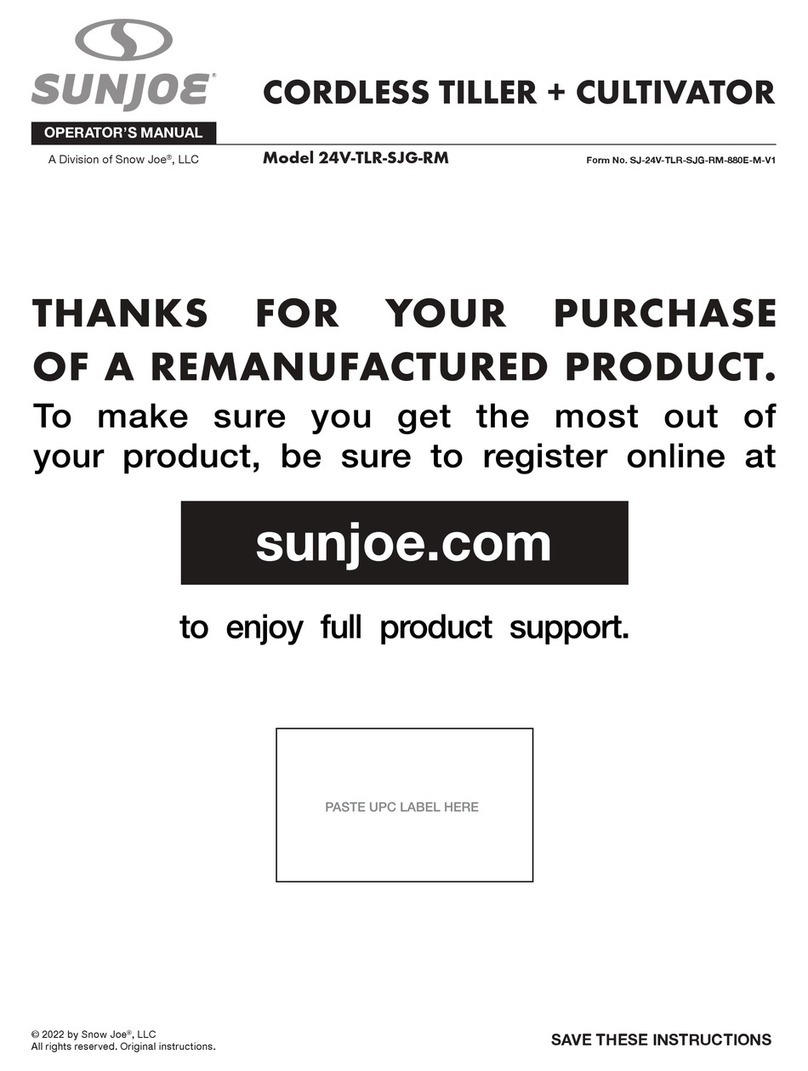
SNOWJOE
SNOWJOE sunjoe 24V-TLR-SJG-RM Operator's manual

GÜDE
GÜDE GEGF 1540.1 Translation of the original instructions
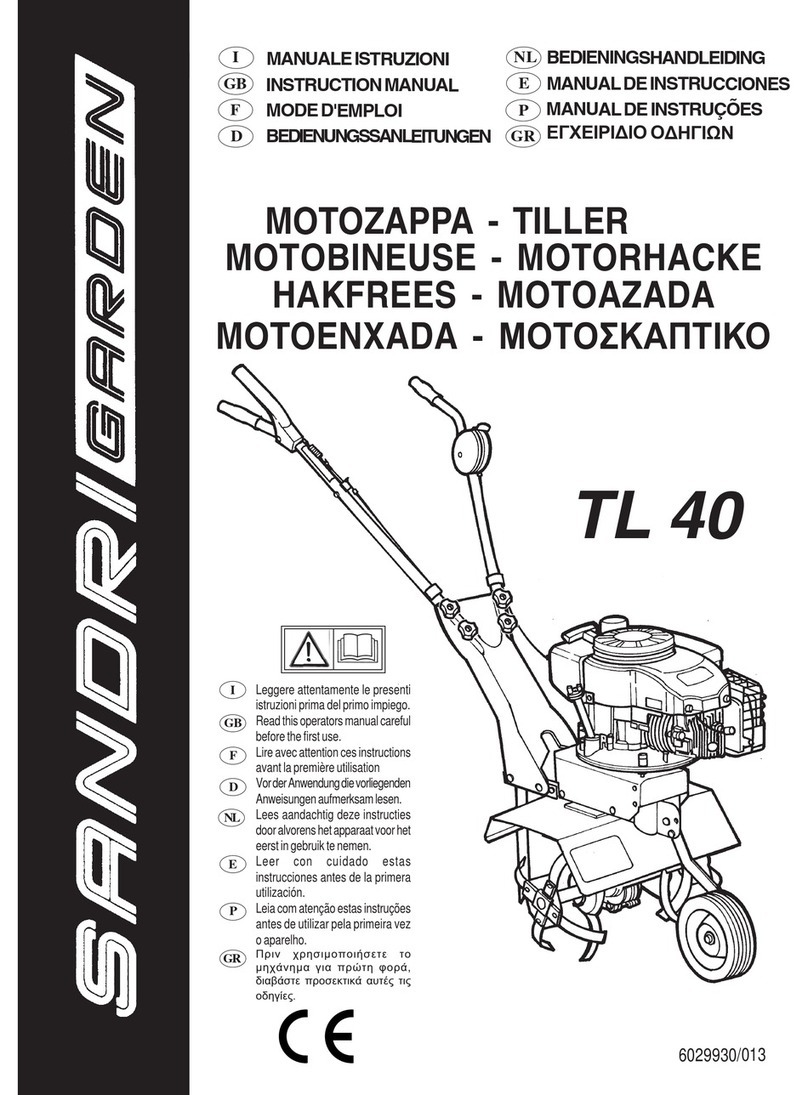
Sandr Garden
Sandr Garden TL 40 instruction manual
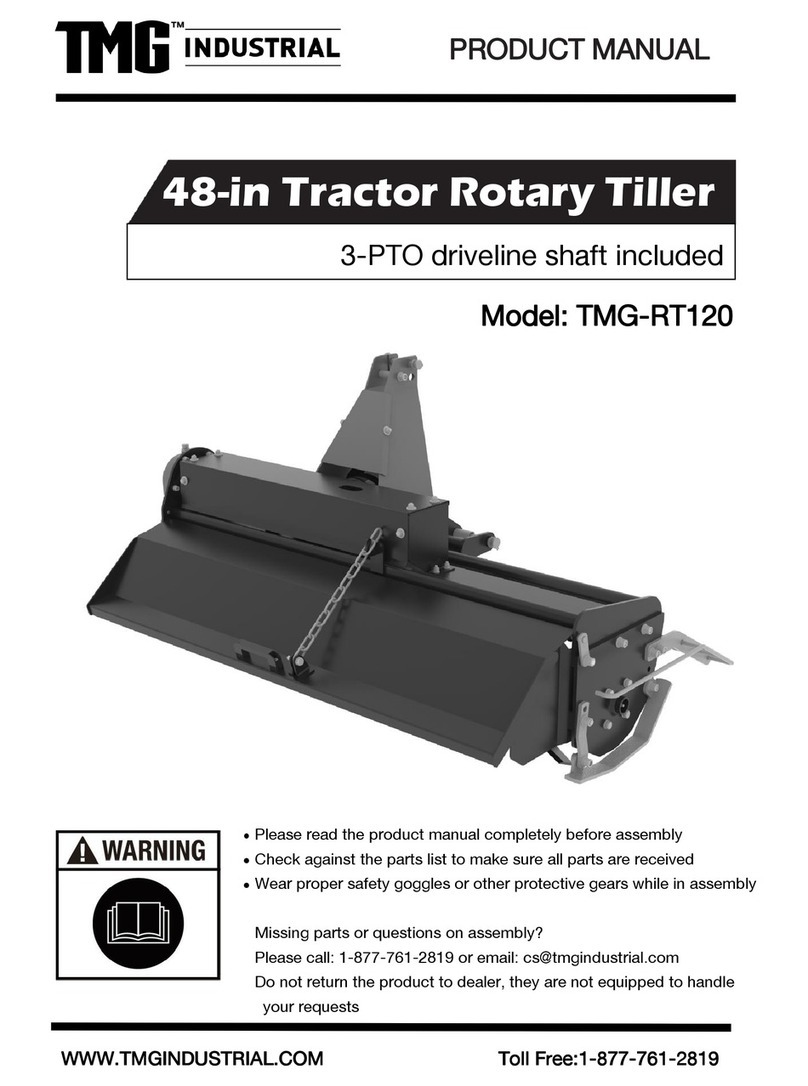
TMG
TMG TMG-RT120 product manual
